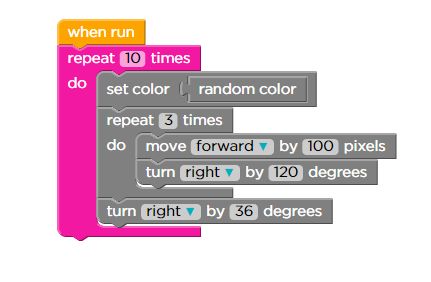Code7 - Stage 8
Functions
Gary Dalton
18 July 2015
Fork on GitHubFunctions
Repetitive tasks can be stored in a small group that can be "called" several times, instead of wasting space with lots of copies of the same instruction.
Objective
- Learn to find patterns in processes
- Think about an artistic task in a different way
Materials
- One jump ring
- One foot of string, thread, or fishing line per person
- 2-4 beads per person
- 2-4 other accessories (buttons, hoops, spacers) per person
- One special bead, prism, or sun charm per person
- One Skills Sheet per person
Vocabulary
Abstraction
Removing details from a solution so that it can work for many problems
Function
A piece of code that can be called over and over
Function Call
The place in your program where you call a function you have defined
Function Definition
The place where you assign a series of actions to one easy-to remember name
Program
Instructions that can be understood and followed by a machine
Variable
A placeholder for a value that can change
- Abstraction: Removing details from a solution so that it can work for many problems
- Function: A piece of code that can be called over and over
- Function Call: The place in your program where you call a function you have defined
- Function Definition: The place where you assign a series of actions to one easy-to remember name
- Program: Instructions that can be understood and followed by a machine
- Variable: A placeholder for a value that can change
Review and Extend
In Stage 7, The Artist II, we drew repeating shapes using code blocks
 |
 |
|---|
- Do you remember what an algorithm is?
- What algorithm might you use to draw a snowman?
Suncatcher
How did I make this?
- I put the jump ring on the string and tied a double knot.
- I put a bead on the string and tied a knot.
- I put another bead on a string, and tied another knot.
- I put a spacer on the string and tied another knot.
- I repeated steps 2-4.
- Finally, I put on the special charm, and tied one last double knot.
With rhythm
"Jump ring, double knot.
Bead, knot, bead, knot, spacer, knot.
Bead, knot, bead, knot, spacer, knot.
Special charm, double knot."

- How many instructions do we have left to go through?
- How many lines do we have left?
- What should we do?
Activity
- Look at the programming sheet.
- Notice that there are sections labeled Skill 1 and Skill 2.
- Any tasks you place there may be called from the program by writing the skill.
Questions?
Try to fill in the skills and program to make a working example of the algorithm.
"Jump ring, double knot.
Bead, knot, bead, knot, spacer, knot.
Bead, knot, bead, knot, spacer, knot.
Special charm, double knot."
Ok, let's make those suncatchers.
Wrap up
Objectives
- What patterns did you find?
- Patterns may be found in art, nature, and code.
Vocabulary
- Abstraction: Removing details from a solution so that it can work for many problems
- Function: A piece of code that can be called over and over
- Function Call: The place in your program where you call a function you have defined
- Function Definition: The place where you assign a series of actions to one easy-to remember name
- Program: Instructions that can be understood and followed by a machine
- Variable: A placeholder for a value that can change